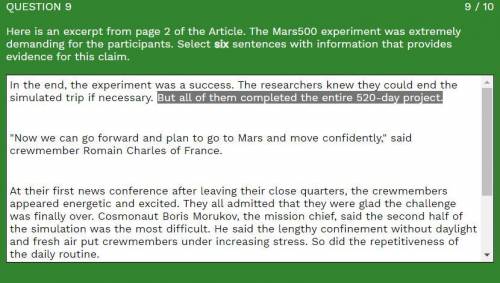
History, 17.09.2021 05:20 alexkrol10
Mars500, the experiment to help determine whether astronauts could handle the claustrophobic conditions they would be subjected to if they were to attempt a mission to Mars, concluded in November 2011.
The crewmembers were under 24-hour observation by scientists. They were confined to a group of cramped, windowless modules the size of school buses. They communicated with their families and space officials via the Internet. But their connection was delayed and occasionally disrupted intentionally to mimic the effects of space travel. The crew showered only once every 10 days or so to acknowledge the need to conserve water on a real mission. They ate food similar to that available on the International Space Station. Midway through the simulation, crewmembers even imitated a landing on the Red Planet. They journeyed from their tight quarters in heavy spacesuits to trudge into a sand-covered room.
In the end, the experiment was a success. The researchers knew they could end the simulated trip if necessary. But all of them completed the entire 520-day project.
"Now we can go forward and plan to go to Mars and move confidently," said crewmember Romain Charles of France.
At their first news conference after leaving their close quarters, the crewmembers appeared energetic and excited. They all admitted that they were glad the challenge was finally over. Cosmonaut Boris Morukov, the mission chief, said the second half of the simulation was the most difficult. He said the lengthy confinement without daylight and fresh air put crewmembers under increasing stress. So did the repetitiveness of the daily routine.
The crewmembers said they coped with the fatigue and stress of isolation by doing exercises and reading books. Some tried to learn foreign languages. They also spent time watching movies, playing computer games, and celebrating holidays together. Crewmember Diego Urbina also credited social networks with helping to relieve the pressure.
"You get the feedback, like all the kids [who] want to go to Mars, and they tell you so many nice things, many things about their own dreams, and that gives you a lot of impulse to go on," Urbina said.
However, what helped most, the crew said, was keeping themselves busy with their work. The researchers conducted more than 100 scientific experiments during the pretend flight.
"I wanted to take part in an interesting adventure and also do something useful for humankind," said Russian team leader Alexey Sitev, a former military diver. "I now feel happy that I have succeeded."
Despite all the efforts to stay busy and motivated, mounting fatigue left the crewmembers dreaming about what they would do after the mock mission ended.
"I wanted to take my family to the sea, lie down, and watch the waves at my feet," said Sukhrob Kamolov. Kamolov is a Russian crew doctor. "And I also dreamed about something that would give me lots of adrenaline."
Kamolov also said that the isolation helped him to see things differently. "I realized that time goes fast, and I must spend more time with my family," he said.
The Associated Press contributed to this story.



Answers: 1


Another question on History

History, 22.06.2019 04:00
Which of the following cultures were among the earliest known inhabitants of north america? a) mayab) incac) anasazi d) olmec
Answers: 2

History, 22.06.2019 08:30
The brought textile workers and an machinery together in the same location. a. agricultural revolution. b. mass production system. c. factory system. d. mass transit system.
Answers: 1

History, 22.06.2019 14:50
What countries was the western front located during world war 1
Answers: 2

History, 22.06.2019 16:20
Which one of the following was not a reason for the emergence of the single-family peasant farm as the basic unit of agricultural production in the early middle ages? select one: a. the mounted soldier made warfare expensive, so many warriors became full-time farmers. b. the declining birthrate made it necessary for entire families to work in agricultural production. c. horses made it easier, although more expensive, for farmers to support themselves. d. it was more economically feasible for landowners to rent their land to farmers. e. villa owners could no longer purchase slaves.
Answers: 2
You know the right answer?
Mars500, the experiment to help determine whether astronauts could handle the claustrophobic conditi...
Questions

Mathematics, 17.05.2021 20:20

Mathematics, 17.05.2021 20:20


Business, 17.05.2021 20:20

Biology, 17.05.2021 20:20

Mathematics, 17.05.2021 20:20

English, 17.05.2021 20:20



Mathematics, 17.05.2021 20:20

Advanced Placement (AP), 17.05.2021 20:20


Mathematics, 17.05.2021 20:20

English, 17.05.2021 20:20

Arts, 17.05.2021 20:20

Mathematics, 17.05.2021 20:20

Mathematics, 17.05.2021 20:20






